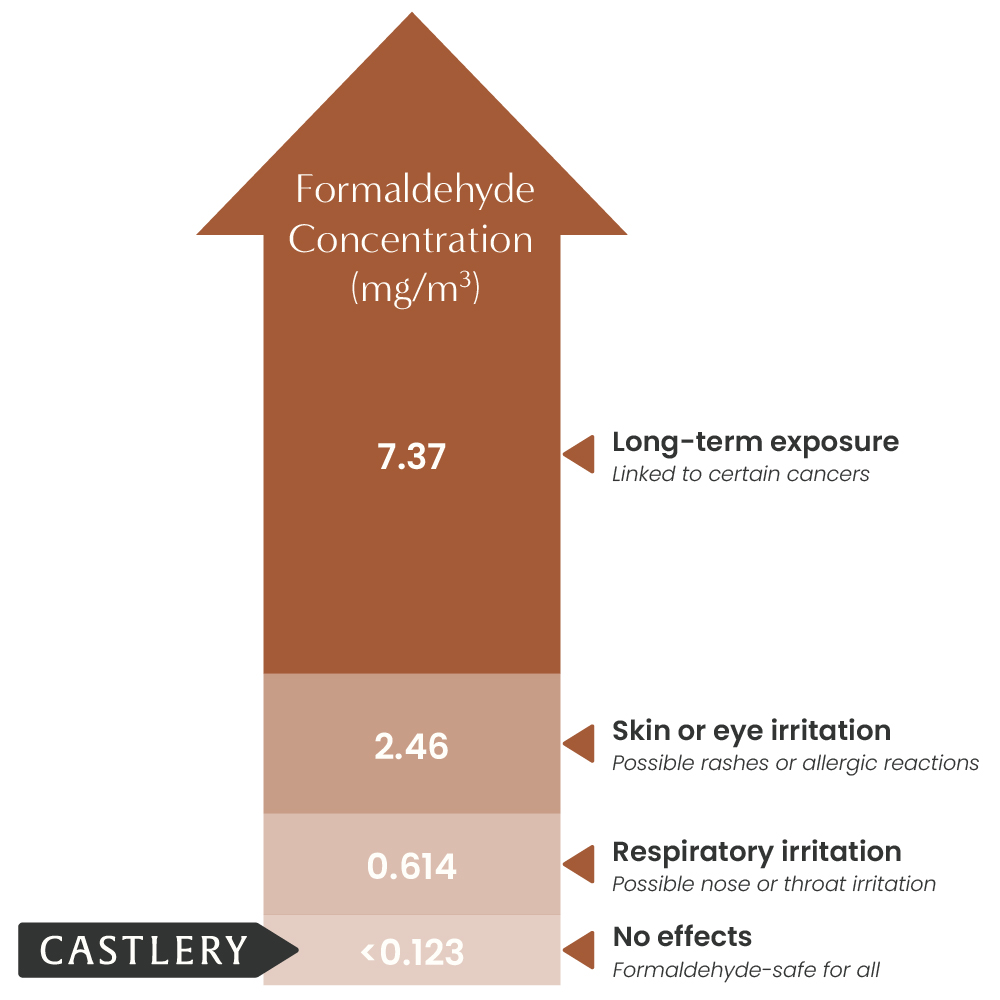
Breathe Safe, Live Well: Formaldehyde-Safe Furniture
When it comes to furnishing your space, safety and style should go hand in hand. One growing concern for many is the presence of chemicals like formaldehyde in furniture materials, which can affect the quality of air.
While that sounds alarming, don't worry. We're here to explain what formaldehyde is, why it's used in furniture, and most importantly, how Castlery prioritises your safety by keeping formaldehyde levels in check.
Understanding formaldehyde and its risks
We’ve all heard about chemicals like formaldehyde, but what is it really? And should you be worried? Let’s break it down.
What is formaldehyde?
Formaldehyde is a naturally occurring chemical found in many products, from household cleaners to building materials. Known as VOC (Volatile Organic Compounds), formaldehyde is a category of chemicals that can evaporate into the air and affect indoor air quality.
In small amounts, it’s generally harmless, but when formaldehyde levels rise, so do the health risks.
Health risks associated with formaldehyde
Cancer risks: The National Cancer Institute has classified formaldehyde as a known human carcinogen. Long-term exposure has been linked to nasopharyngeal cancer and myeloid leukaemia, making it crucial to minimise exposure, especially in your home.
Skin and eye irritation: Formaldehyde can also irritate the skin, causing rashes and, in some cases, allergic reactions. Your eyes may feel burning, stinging, or watery when exposed to higher levels of this chemical.
Respiratory irritation: If you’ve ever felt your throat burn after being around strong chemicals, you’ve probably experienced formaldehyde irritation. According to the American Lung Association, formaldehyde at higher levels can trigger symptoms like coughing, wheezing, and even asthma attacks.
Increased sensitivity in certain groups: Children, the elderly, and individuals with pre-existing respiratory issues or asthma tend to be more sensitive to formaldehyde exposure. Even small amounts can have a noticeable impact on their health.

A chart showing the range of formaldehyde concentrations and their potential effects. At Castlery, our products are designed to meet stringent safety standards.
Formaldehyde in furniture: What you need to know
It may surprise you to learn that formaldehyde is used in the manufacturing of many common household items, including furniture. But how does it get there?
How does formaldehyde end up in furniture?
Formaldehyde is primarily used in adhesives, coatings, and finishes. It’s especially prevalent in engineered wood products, such as particleboard, plywood, and medium-density fibreboard (MDF).
These materials are widely used due to their durability and cost-effectiveness because it’s created by bonding layers of wood or wood fibres with resins or adhesives. However, many of these adhesives can release small amounts of formaldehyde over time, a process known as off-gassing.
Solid wood: The formaldehyde-safe option
Solid wood, on the other hand, does not contain adhesives that bond the layers together. When you choose solid wood furniture like the Seb Extendable Dining Table or the Vincent Coffee Table, they are crafted from a single piece of wood.
This means that they don’t contain additional formaldehyde, making solid wood a safer choice when you’re concerned about indoor air quality.
How Castlery keeps your space formaldehyde safe
Your well-being isn’t just an afterthought - it’s the very foundation of everything we do.
We believe that you should have a safe space, and that’s why we take extra steps to ensure that our furniture meets or exceeds industry standards.
We adhere to the TSCA Title VI standard, which is a stringent regulation ensuring that formaldehyde emissions from composite wood products are kept within safe limits.
This mirrors the E1 standard, which is widely recognised in Europe to ensure low formaldehyde levels.
What is the E1 Standard?
The E1 Standard is a European benchmark that limits formaldehyde emissions from engineered wood. To be classified as E1, materials must emit no more than 0.1 ppm (parts per million) of formaldehyde, which is considered a safe level for indoor air quality.
This standard is widely accepted across Europe and Australia as the mark of safety for low-formaldehyde furniture.
What is the TSCA Title VI standard?
The Toxic Substances Control Act (TSCA) Title VI is a federal regulation from the USA that limits formaldehyde emissions in products made from composite wood, such as plywood, particleboard, and MDF.
This ensures that our furniture releases only very low levels of formaldehyde, well within the limits considered safe for indoor air quality. So, when you buy a piece of Castlery furniture, you can be confident that it complies with these rigorous standards.
How to reduce formaldehyde exposure in your space
While we take significant steps to ensure our furniture is safe, there are other actions you can take to further reduce formaldehyde exposure in your space:
Choose formaldehyde-safe products: When buying new furniture, look for formaldehyde-safe options like solid wood furniture.
Ventilate your space: Make sure your space is well-ventilated, especially after receiving new furniture. Open your windows and allow fresh air to circulate to help reduce formaldehyde levels.
Air out new furniture: After unboxing new furniture, let it air out for a few days before using it fully. This can help reduce any off-gassing that may occur initially.
Control humidity and temperature: High temperatures and humidity can increase formaldehyde emissions. Keeping your space cool and dry will help minimise the risk of formaldehyde exposure.
Creating a safe space to thrive
Formaldehyde may be a common part of modern furniture production, but with the right precautions, it doesn't have to be a major concern. By understanding its presence and potential risks, you can make better choices to reduce exposure.
At Castlery, we take significant measures to ensure our furniture meets strict formaldehyde safety standards, prioritising your well-being. While we do not offer formaldehyde-free furniture, our adherence to rigorous standards means that emissions are kept well within safe limits - so you can shop easy and create a formaldehyde-safe space for you and your family.